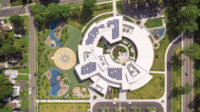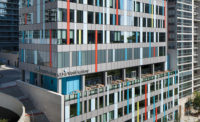Dallas
Like a proud parent, Denise Davis, an associate at the Communities Foundation of Texas, shows off photographs of the Kathlyn Joy Gilliam Collegiate Academy whenever she is asked about exciting developments in early-college-high-school programs. Davis, whose statewide foundation helps college-readiness programs get off the ground, has much to brag about: The Gilliam Academy, serving motivated but low-income students, had a graduation rate of 100 percent last year. All students graduate with college credits, and some walk away with associate's degrees.
A 20-minute drive south of downtown Dallas, Gilliam is the Dallas Independent School District's third early-college high school. While its predecessors rent space on existing college campuses, the $21.3 million Gilliam is the first stand-alone college-prep high school built from the ground up in Texas. And it is one of the district's most striking success stories.
Opened in August 2011, the 104,000-square-foot facility sits on a 10-acre plot on the top of an uncharacteristically hilly stretch of grassland, just off a six-lane road that connects to the main interstate. The steel-framed building is tucked into the northeast corner of the sprawling, though still developing, 260-acre University of North Texas at Dallas campus. Oriented with its long axis in an east'west direction to minimize heat gain and glare, the low-slung structure, with a gradually canted roof, is clad in fiber-cement board and brick. The building is designed to complement the neighboring university's brick and window-lined facades, while also having its own declarative aesthetic.
When the architects from SHW Group's Dallas office met with district officials to first discuss the design of a school devoted to college readiness, they quickly realized they had entered uncharted territory: They could not simply scale down a standard 3,000-student public high school for Gilliam's much smaller population of 400 students. 'It was a different kind of building they were asking for,' says Vandana Nayak, the SHW project manager. 'There was no prototype in the state of Texas.'
The architects encouraged the school district to take a step back and spend a month going through a formal visioning process with administrators, teachers, students, parents, legislators, and police to outline their goals for the space. The committee's report, which emerged after 15 hours of meetings, emphasized collaborative, informal, and unstructured learning''new words' in school design, says Terry Hoyle, a principal at the firm. 'Students are learning in different ways than they did 50 years ago, and the space needed to reflect that.'
Using the report as a guidepost, the architects came back with two schemes for the district to choose from: a campus plan with separate buildings connected by a lawn, or a single building with a large common area. The district opted for the latter because of security concerns. Much like a college student union, the two-story building has an open, central double-height atrium with north-facing clerestory windows. It contains a college and career center, cafeteria, library, and other collaborative spaces, including four demountable glass conference rooms for small-group work. Classrooms, with generous windows affording sweeping views of the city skyline, run along the northern wall on both floors and are designed to be as versatile as possible so teachers can trade them throughout the day. A 7,500-square-foot gym, a buffet-style serving area, and a 250-seat lecture hall with a retractable back wall for outdoor performances anchor the south side.
The school is designed to give upperclassmen more independence, and their classrooms on the first floor offer immediate access to communal spaces'and potential distractions'like the cafeteria. (Upperclassmen are also free to leave campus to attend classes at a community college four miles away, though this year 11 professors decided to come to them and teach on-site.) The younger students have classes upstairs. 'The older students can come and go and self-regulate,' says Gayle Ferguson Smith, Gilliam's principal. 'And the younger students can watch what's happening below and model their behavior.'
Also on the second floor, a yellow fiber-cement-board-clad box called the 'perch' looms over the atrium and protrudes out the side of the building, sheltering an observation deck underneath. Elevated by artfully angled steel columns, the space contains meeting rooms and staff offices'a blaring physical reminder to students to seek academic support. With large windows, the staff has a bird's-eye view of the first floor'one of many design tricks that lead students to complain (and teachers to brag) that there is nowhere to hide on campus. Says Nayak, 'The goal was to create a collegiate feel, but still have supervision.'
Completion Date: August 2011
Gross square footage: 104,000 square feet
Total construction cost: $21.3 million
People
Owner:
Architect:
Personnel in architect's firm who should receive special credit: Architect of record: Terry Hoyle AIA Interior designer: Gwen Morgan IIDA Engineer(s): see under consultants
Consultant(s): General contractor: Satterfield & Pontikes Photographer(s): Luis Ayala Renderer(s): Dan Fletcher
CAD system, project management, or other software used: |
Products
Structural system Exterior cladding: Fiber Cement Board by Swiss Pearl, Masonry by Acme Brick and Blackson Brick. Roofing: Soprema, Architectural Building Components
Windows: Storefronts and Curtain Walls
Doors Metal doors: EFCO, Stainless Doors, Inc. Wood doors: Graham by Assa Abloy Sliding doors: EFCO Fire-control doors, security grilles: Glass Folding Door by Solar Innovations Upswinging doors, other: Bifold Doors by Schweiss
Hardware Closers: LCN Exit devices: Von Duprin by Ingersoll Rand Pulls: H. B. Ives Security devices: Ingersoll Rand
Interior finishes Suspension grid: Armstrong Demountable partitions: Dirtt Kitchen: Edward Don Millwork: Terrill Wall coverings: Forbo, Thermocromex Paneling: Wood Paneling by Terrill and 9Wood Solid surfacing: Corian and Quartz (at Food Service) Floor and wall tile: Kerlite (restroom walls), Daltile (restroom and kitchen walls and floors) Resilient flooring: Nora Rubber Flooring Carpet: Collins & Aikman Wood Flooring – By 9Wood and Plyboo Special interior finishes unique to this project: Thermocromex, Vitracolor Magnetic glass markerboard, custom handrail with integrated lights by Myrex
Furnishings Fixed seating: Hussey Seating Other furniture: Library furniture by Tesco
Lighting Downlights: Sylvania, Zumbtobel Exterior: Bega Dimming System or other lighting controls: Lightolier
Energy |










Post a comment to this article
Report Abusive Comment